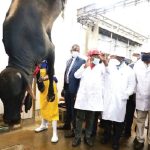At its inauguration, the Second Republic set its eyes on the goal of achieving National Food Security through local production.
That meant several interventions to raise aggregate production, among them:
- increasing access to, and greater utilisation of the Land;
- sustainably weaning our agriculture from weather-related vicissitudes, thus climate proofing it;
- supporting communal and smallholder Agriculture through various input supply schemes, foremost the Pfumvudza/Intwasa Scheme;
- stabilising Agricultural Finance and Marketing and,
- modernising the Agricultural sector through mechanisation, science and more intensive farmer extension support.
Because of these far-reaching interventions, we were able to achieve a national surplus in a short space of just two seasons, peaking in the 2020-21 season.
Because of that progress, we have been able to mitigate the adverse effects of the 2021-22 season which was affected by mid-season drought.
We must draw hard lessons from this fluctuating performance so we move into the future with greater certainty and predictability.
The weather-induced variations in our Agricultural performance and cereal output shows more needs to be done to climate-proof this sector for sustainable national food security. To that end, we continue to build more lakes and dams, as well as hitching these to agricultural land through modern irrigation systems.
While our aggregate cereal output often surpasses our national requirements, I am concerned that on closer examination, productivity remains low.
Our farmers and the whole Agricultural Society must be challenged to go beyond the aggregate goal of National Food Self-Sufficiency. We must now begin to build efficiencies all round, so more and more we work with farmer-and farm-targeted goals of productivity.
When I look at our output per hectare, or the input-output ratio, both in relation to leading food producers in our Region and in the world, we still have more to do. This sets a new focus for us, both as individual farmers and as an industry. There are lots of inefficiencies belied by positive national aggregate output.
Our attention now has to turn to how much we produce per hectare; per farmer/household, and per given quantity of key inputs. All this takes us into the realm of productivity, while also getting us to focus closely on each variable in the whole gamut of our interventions.
That also covers post-harvest losses which reduce our marketable surplus.
Continued next page
(94 VIEWS)


